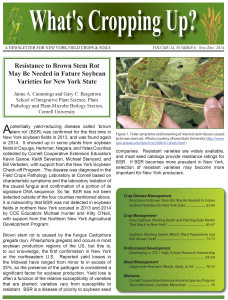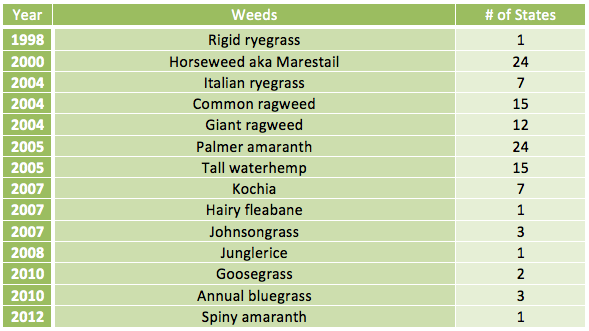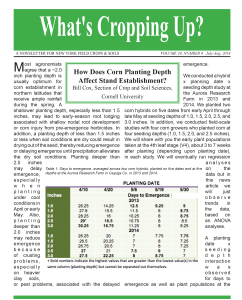Sandra Wayman, Brian Caldwell, Chris Pelzer, and Matthew Ryan
Sustainable Systems Cropping Lab, Soil and Crop Sciences Section, School of Integrative Plant Science, Cornell University
The goal of this project was to quantify soil weed seedbanks in the fields of four local organic farms. In particular, we have heard from organic farmers that red clover (Trifolium pratense L.) often volunteers profusely in some fields after tillage. This may be due to the common practice of harvesting red clover for seed on these farms, during which a substantial number of seeds shatter and are dropped on the field. Under these conditions, red clover could act either as a valuable nitrogen-fixing resource or perhaps as a weed.
We asked four organic grain farmers to identify “weedy”, “clean”, and “high clover” fields on their farms. We took soil samples from these fields, did greenhouse germination bioassays to allow weed seeds to germinate from the soil samples, and then counted the seedlings of each species. This report details the results from the first year of sampling, which is being repeated this year.
Sampling Protocol
Fields were sampled in the spring of 2015, before spring weed germination. Our sampling protocol was to divide each field into four evenly sized quadrants and take 30 soil cores from inside each quadrant. We avoided sampling from headlands. We used a 5/8th inch diameter soil probe and sampled to a depth of 8 inches. Field conditions generally made for easy soil sampling. Soil samples were kept in a cooler until greenhouse weed seedbank bioassay. We also dried separate subsamples of the soil to calculate gravimetric water content and estimate bulk density.
Greenhouse Germination Bioassay

In the greenhouse, 1 kg of soil from each quadrant was spread out in flats (10 x 10 inches) over a thin layer of vermiculite and watered daily (Figure 1). Weed seedlings were identified to species (or at least genus, if unknown), counted, and removed from the flat. After all weed seedlings were removed, the flats were left to dry for a few weeks, soil from each flat was mixed, and then watering began again to encourage a second flush of weeds. Data presented are from both flushes of weeds.
Red Clover Seedbank
Red clover was the 6th most common species accounting for approximately 5% of all emerging seedlings. Our results show that these organic farmers do in fact have red clover in their seedbanks, bolstering their observations that the red clover seedbank likely increased via intentional planting and losses from seed harvest. The average density of red clover ranged from 0 to 23 seedlings per kg soil across all 12 fields (Figure 2). Half of the fields had over 4 seedlings per kg of soil, which is quite a lot. For example, one seedling per kg of soil equates to over 100,000 seeds per acre in the top inch of soil—enough for a good stand of red clover.

Interestingly, across all four farms, red clover populations were greater in the field chosen as “weedy” compared with the field chosen as “high clover.” This suggests that these organic farmers might not be as good at identifying which fields actually have the highest red clover populations. The red clover seedbank was densest in the fields from Farm 3 (Figure 2). This farm has been under organic management for over 30 years, and occasionally they harvest red clover for seed. Compared with Farm 3, red clover seedling emergence was much lower in the “high clover” fields on the other farms. In the spring of 2016 on Farm 2 we observed an abundant stand of red clover in the “high clover” field, even though red clover was not planted the previous year (Figure 3). Oats had been the previous crop in this field in 2015.

Weed Seedbank Density
On Farm 3, total weed seedlings were comparable to the other farms and similar among the three different fields chosen by the farmers (Figure 4). Specifically, the “weedy” field on Farm 3 was no weedier than either the “clean” field or the “high clover” field.
Total weed seed density in the “weedy” fields on farms 1, 2, and 4 tended to be higher than those in the “clean” fields. This indicates that the farmers were pretty good at knowing what fields were weedy and what fields were not. Although the total seedbank size might seem large, these densities are comparable to other studies in organic and non-organic fields. More importantly, experienced organic farmers are typically able to manage competition from weeds and grow high yielding crops, so even high weed seedbank densities are not necessarily a problem.

Weed Species Diversity
Most weed species observed across the four farms were summer and winter annuals and there were fewer perennials (Figure 5). The top 12 species accounted for over 75% of all seedlings counted in the greenhouse bioassay. Pigweed (redroot and Powell), giant foxtail, common ragweed, and common lambsquarters dominated weed counts and are warm-season species. The winter annuals purslane speedwell and wild mustard also occurred at high density. Path rush, yellow woodsorrel, and broadleaf plantain are low-growing, relatively non-competitive perennials. Fleabanes (Erigeron spp.) include both annuals and perennials.
Because of the relatively diverse rotations on these farms, which include warm season grains, winter cereals, and perennial legumes, a high diversity of weed species was expected. The weed community that we observed would persist by reproducing and replenishing the soil weed seedbank when conditions allowed.

Average weed species richness (i.e. number of species per kg soil) ranged from 6 species per kg soil in the “high clover” field from farm 1 to 27 species per kg soil in “weedy” field from farm 4 (Figure 6). As some weed species might provide benefits similar to cover crops, and greater biodiversity is typically assumed to be beneficial, high species richness can be good, especially when combined with low weed seedbank density. However, as the number of weed species in a field increases, so does the probability that a highly competitive/problematic weed species will be present in the community.

As not all weed species are equal in terms of their potential to reduce crop yields, we list the top species accounting over 50% of all individual seedlings counted on each farm below. Species are listed in order of abundance.
Although no single weed was part of the top 50% across all farms, common ragweed was dominant at three farms and several other species were dominant at two farms. This indicates that these weeds are likely common on other organic farms in the region. We are currently repeating this study and will be evaluating the correlation between weed abundance and weed community composition between 2015 and 2016. We also analyzed a subsample of soil for soil health properties and will be testing the relationship between soil properties and weeds.
This work was supported by grant proposal titled Agroecological Strategies for Balancing Tradeoffs in Organic Corn and Soybean Production from the Organic Transitions Program (ORG) National Institutes for Food and Agriculture (NIFA) U.S. Department of Agriculture (Project: 2014-51106-22080). Any opinions, findings, conclusions, or recommendations expressed in this publication are those of the authors and do not necessarily reflect the view of the U.S. Department of Agriculture.
Special thanks goes to Scott Morris for weed identification assistance and to the four anonymous farmers for the use of their fields.










